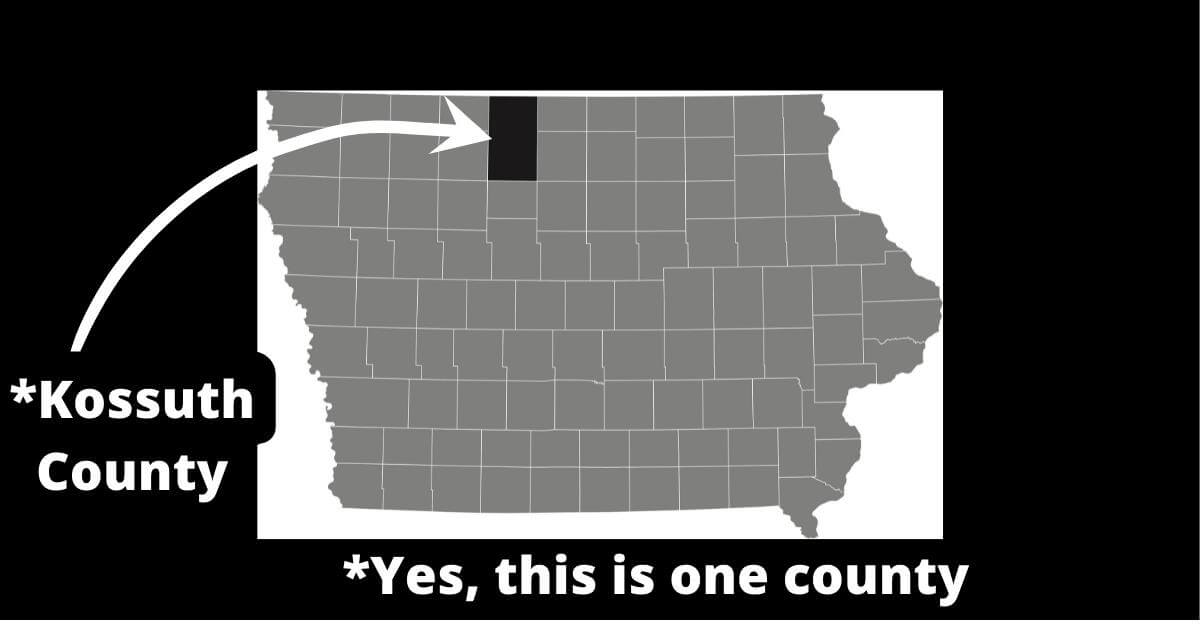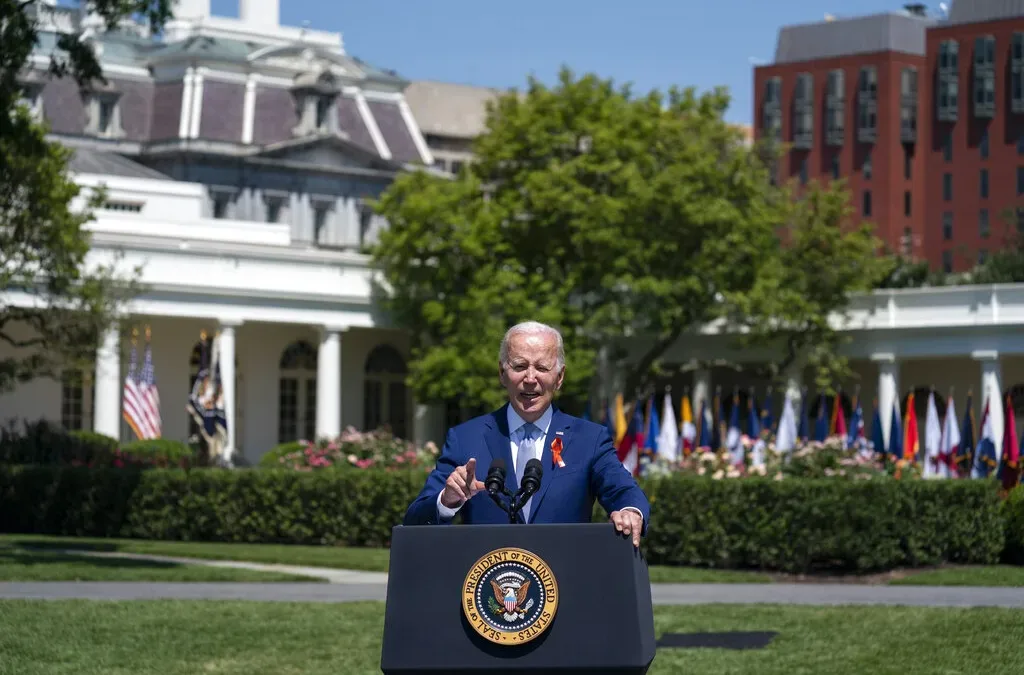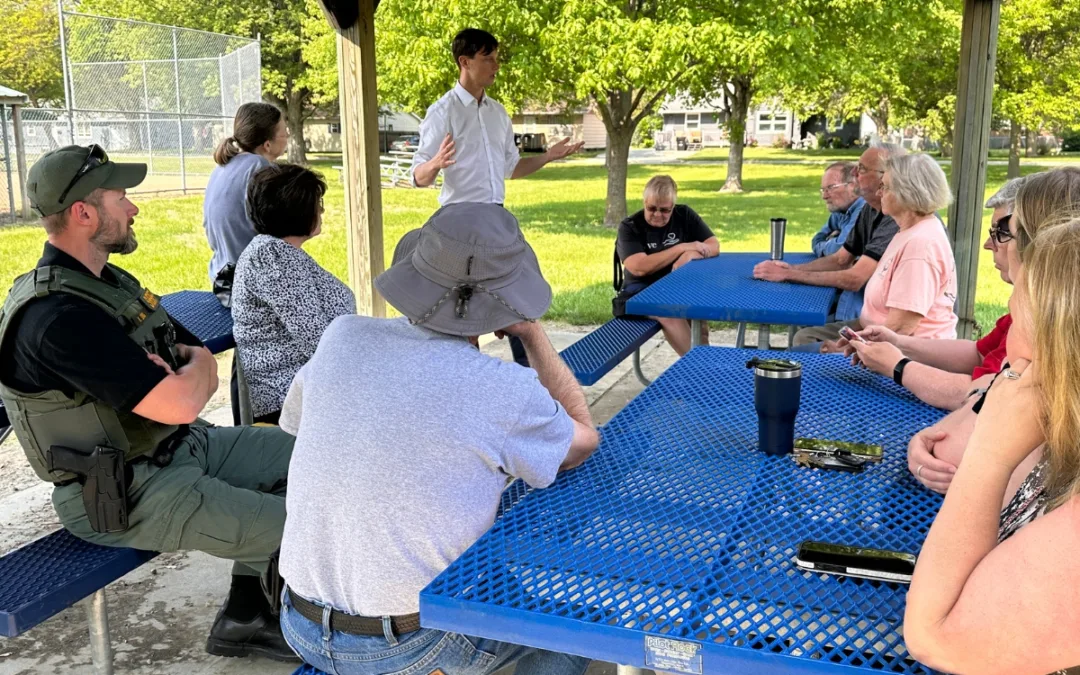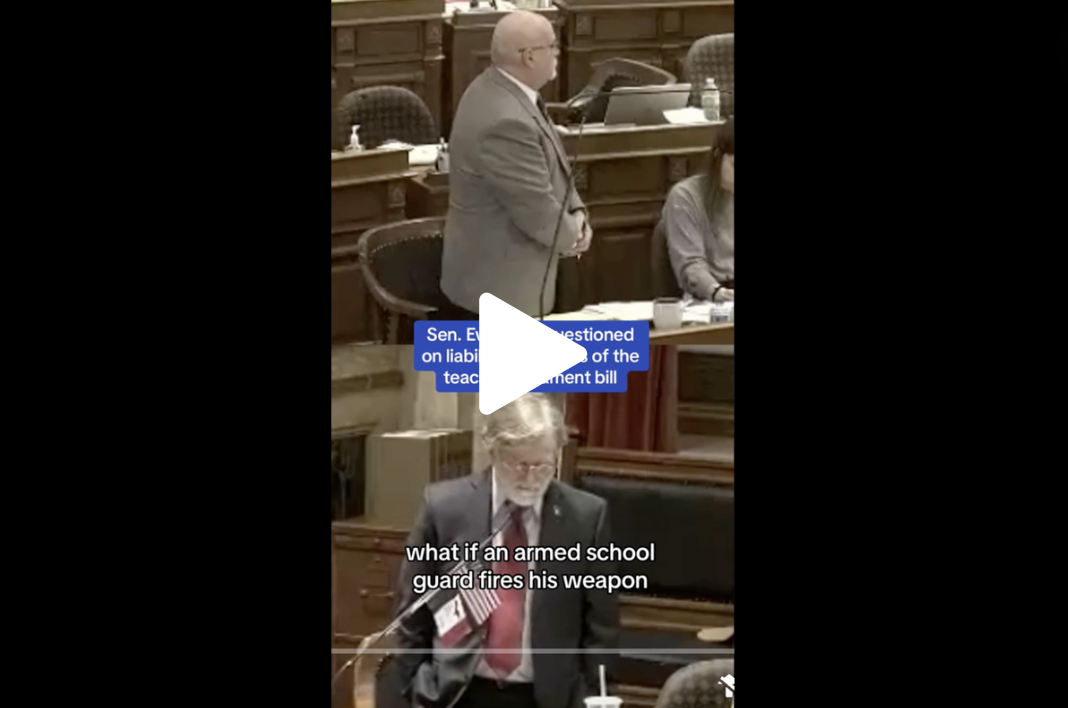
Behold, Iowa's largest county: Kossuth!
Anyone who’s stared at a map of Iowa’s 99 counties has probably pondered this question: What’s up with Kossuth County?
At 974 square miles, Kossuth is Iowa’s largest county in terms of total land area and sticks out on any state map because of its length. North to south, Kossuth is about 41 miles long whereas O’Brien County, for example, is 24 miles north to south.
Another fun fact: O’Brien County’s borders go 24 miles in each direction and it is a perfect square. Additionally, the county seat of Primghar is the only Primghar in the world and it was purposefully established directly in the center of O’Brien County.
The obvious answer to why Kossuth is so large is that it was supposed to be two counties—on more than one occasion—but, like a black hole composed of farmland, Kossuth absorbed those wannabe counties.
[inline-ad id=”0″]
Kossuth County was part of a major legislative act passed by the Third Iowa General Assembly on Jan. 15, 1851, that created 50 new counties, giving Iowa an even 100.
Like O’Brien County, which was also created by this legislation, Kossuth County was a perfect square and went 24 miles in each direction when it was created.
North of it was Bancroft County, Iowa’s fabled 100th county—or was it?
A handful of counties that no longer exist were created by this act including Buncombe, Fox, Risley, Wahkaw, and Yell counties.
At the time of its creation, Bancroft County was 24 miles wide and 17 miles from its southern border (Kossuth County was below it) to the Minnesota state line. Bancroft (and Kossuth) County’s landscape was described as “trackless prairie” and endless swamp,” according to “The Counties and Courthouses of Iowa.”
Most of the counties created by the 1851 act were uninhabited or sparsely inhabited by white settlers and Kossuth County boosters used this to their advantage to absorb Bancroft County, although their plans were far more ambitious.
Algona, the Kossuth County seat, was founded in 1854 by brothers Asa C. Call and Ambrose A. Call. The town was originally called Call’s Grove—I’m sure you can deduce why—and they were the first white settlers in Kossuth County.
The Call brothers were influential in Iowa politics, especially Asa, who was a judge. Judge Call persuaded the Iowa Legislature in 1855 to expand the border of Kossuth County to include all of Bancroft County to the north and the northern half of Humboldt County to the south. The other half of Humboldt County was absorbed by Webster County.
However, two years after it approved its demise, the Iowa Legislature voted to restore Humboldt County. This forced Kossuth County to give up all eight townships it absorbed while Webster County got away with only returning four of the eight townships it acquired.
So why did Bancroft County get added to Kossuth County? According to the Iowa Legislative Services Agency (LSA), Bancroft County was never formally organized, which made it ripe for the picking.
The 1857 act that restored Humbolt County did not affect the former Bancroft County, but a second attempt to split Kossuth County arose in 1870 when the Iowa Legislature called for the formation of Crocker County in the same area that once housed Bancroft County.
According to the LSA, residents of southern Kossuth County didn’t take kindly to the formation of Crocker County because they enjoyed the designation of being Iowa’s largest county—something that seems to be true to this day.
Rather than bellyache, the southern Kossuthers (pretty sure I just made that word up) took to the courts. They argued that Crocker County did not contain the minimum of 432 square miles required by the Iowa Constitution to be a county.
For the record, there are at least 13 Iowa counties that don’t meet this criterion, including Dickinson County—home of the Iowa Great Lakes and the inspiration for an early “X-Files” episode—which was also part of the 1851 county expansion that created Kossuth.
However, the Iowa Supreme Court agreed with the southern Kossuthers’ argument and the act that created Crocker County was deemed unconstitutional.
I should also note that Kossuth County did not make it easy for its northern residents to separate. According to “History of Kossuth County,” the Kossuth County Board of Supervisors instructed the county treasurer to continue to collect taxes from Crocker County residents and the new county. This meant Crocker County was broke.
Also according to “The History of Kossuth County,” the Kossuth County Board of Supervisors approved a resolution that threw massive amounts of shade at Crocker County and justified why they continued to collect taxes there even after Crocker County asked them if they could stop:
“..there would be time enough to adjust the final differences between the counties whenever Kossurth had evidence that such as county as Crocker existed.”
Kossuth: Iowa’s largest and most shady county.
After an inglorious 19 months on its own, Crocker County was reabsorbed by Kossuth County, although it never left according to the tax rolls.
You would think after two failed attempts to divvy up the map monstrosity that is Kossuth County the state would get the message and leave the gentle giant alone, but then you would be wrong.
In February 1913, the Iowa Legislature again tried to separate northern Kossuth County—the third version of this area would be called Larrabee County—from its southern half. This was a smart play by the northern Kossuthers since the county would be named after former Iowa Gov. William Larrabee, who had died the year before.
However, the southern Kossuthers were having none of that.
After intense lobbying, the upstarts from the yet-to-exist Larrabee County persuaded the legislature to introduce a bill that would allow only people in northern Kossuth County to vote in an election to determine whether or not that area would remain in Kossuth or become its own county.
That measure didn’t garner enough support in the legislature, but a petition by the southern Kossuthers to make it a county-wide vote was successful. In 1914, Kossuth County voters—both north and south—took to the polls. The measure to split the county was overwhelmingly defeated 3,599 to 920, according to the LSA.
The third time was the charm and there hasn’t been another formal attempt to split up Kossuth County since.
Politics

Biden announces new action to address gun sale loopholes
The Biden administration on Thursday announced new action to crack down on the sale of firearms without background checks and prevent the illegal...

Biden cancels student loan debt for 2,690 more Iowans
The Biden administration on Friday announced its cancellation of an additional $7.4 billion in student debt for 277,000 borrowers, including 2,690...
Local News

No more Kum & Go? New owner Maverik of Utah retiring famous brand
Will Kum & Go have come and gone by next year? One new report claims that's the plan by the store's new owners. The Iowa-based convenience store...

Here’s a recap of the biggest headlines Iowa celebs made In 2023
For these famous Iowans, 2023 was a year of controversy, career highlights, and full-circle moments. Here’s how 2023 went for the following Iowans:...










